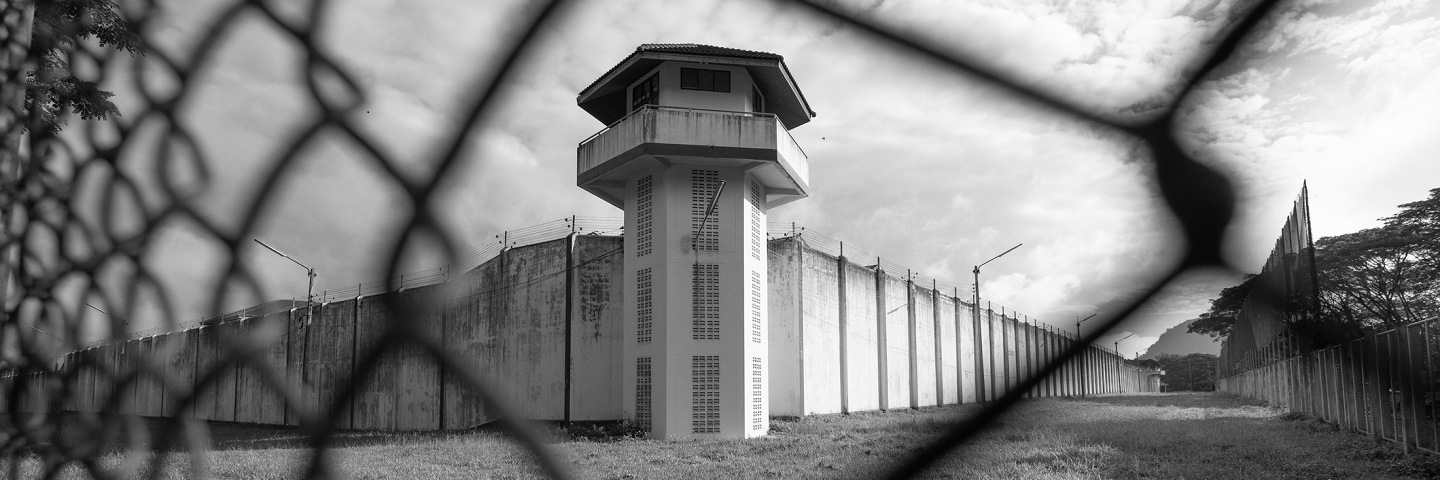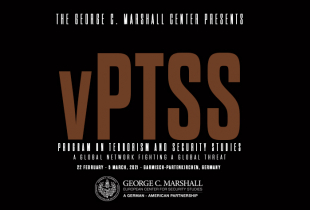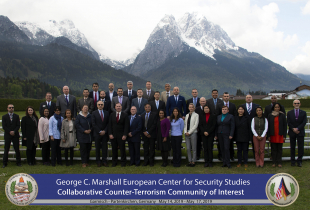
The Prison Terrorism Nexus: Recommendations for Policymakers
Among the many challenges in the fight against terrorism today is the issue of terrorists within prisons. Cross-pollination of terrorist and criminal networks and, in particular, the radicalization and recruitment of ordinary criminal offenders present significant and growing threats to security. What can countries do to manage and reduce these threats?
To discuss these issues and exchange best practices, the Marshall Center hosted a Global Counter-Terrorism Alumni Community of Interest (COI) workshop from 29-31 August, 2017. Six alumni from the Americas, Europe, Asia, and the Middle East, as well as French and U.S. subject matter experts, shared their countries’ national experiences. This served as a catalyst for discussion among sixty-five counter-terrorism (CT) professionals from forty-six countries. The following recommendations are the product of these discussions.
1. Include prisons in national CT strategies and develop an action plan to counter radicalization in prisons. COI participants identified insufficient political will and attention to the issue of prison radicalization as a key challenge. Inclusion of prisons within national CT strategies may help to focus attention on the issue while clarifying the roles and responsibilities of relevant agencies. It is also essential to develop research-based action plans for the management of terrorist offenders in prison in order to reduce the level of risk and prevent further radicalization.
2. Improve information sharing between prison authorities, law enforcement, and intelligence agencies. Participants identified a need for an integrated information and intelligence sharing effort as terrorists progress through the criminal justice system. Prison officials need detailed information from the arresting agency on terrorists’ background, associates, level of risk, etc. in order to develop individually-tailored risk-management plans. Likewise, law enforcement and intelligence officials must be updated on prisoners’ activities while incarcerated, so they can be ready when terrorist are released.
3. Review the penalties for terrorism offences and consider harsher sentencing. Sentences for acts of terrorism need to be sufficient to mitigate the risk. Short sentences can result in prisons merely serving as “terror and crime universities,” where both terrorists and criminals make new contacts and learn new skills. In some cases, non-custodial penalties may be more appropriate for low-level terrorism offences, while more serious crimes should ideally be met with mandatory sentences of ten years or more. Sentences should be increased if terrorists attempt to recruit others in prison. Finally, governments should consider the option of indefinite detention for terrorist offenders who show no signs of reform on completion of their sentence (as is the case in Australia).
4. Isolate high-risk terrorists. A flexible approach is needed regarding the distribution of terrorists in prisons. Extremist recruiters and other high-risk terrorist offenders should be kept in isolation to minimize their opportunities to radicalize members of the wider prison population. Management of lower risk terrorists is more complex and depends on the specific situation. Ideally, they should be separated from the general prison population, both to reduce contact with ordinary offenders and to facilitate monitoring and security. However, concentration of terrorist offenders also carries risks.
5. Appropriately train and resource prison staff. Provide CT and counter-radicalization awareness training so that prison staff can recognize potential indicators of radicalization and recruitment. Develop and implement a plan to improve the professional capacity, status, and motivation of corrections officers so they are better able to resist intimidation, corruption, and influence by resourceful and motivated inmates.
6. Vet religious leaders with access to prisons. Exposure to religion can be a powerful part of a prisoner’s de-radicalization and reform, however officially appointed religious leaders are viewed with suspicion, while “unofficial” parties sometimes have negative or subversive agendas. A program is therefore needed to vet unofficial religious personnel before they are given access to prisons.
7. Establish practical rehabilitation programs for extremist offenders. Any “de-radicalization” programs within prisons should also involve educational opportunities and vocational training in order to assist prisoners’ eventual reintegration into society.
8. Don’t overlook the role of families. The families of terrorists play an important role both while the prisoner is incarcerated and upon release. Assessment of the situation of families of terrorists in prison is helpful to determine if and how they can be a positive influence. Addressing family needs (for example through social, psychological, and/ or financial assistance) can reduce their vulnerability to exploitation by terrorist organizations and also help to build trust, which is extremely valuable for the rehabilitation process.
9. Implement comprehensive post-release programs. While post-release efforts are important for all prisoners, they are particularly important for former terrorists and radicalized criminal offenders who may be vulnerable to reconnecting with former associates or recruitment by extremist groups. Job opportunities, counseling, and mentoring programs are all important ways of reducing this risk. Such measures should be part of multi-agency protection plans, including the relevant security services, in order to simultaneously manage the level of risk and ensure public safety.
10. Share experiences and best practices. As with every aspect of addressing the international terrorist threat, there is a need to share information across borders. Prison and probation authorities are no exception to this rule. It is therefore important to establish regular platforms for the exchange of experiences and best practices in dealing with terrorists in prison. This could be achieved through a variety of means, including conferences, shared databases, research, and publications. Many countries are struggling with the issue of terrorists in prison. Finding optimal solutions will depend on more proactive sharing of these experiences.
For Academic Citation
James Howcroft, “The Prison Terrorism Nexus: Recommendations for Policymakers,” Marshall Center Perspectives, no. 2, September 2017, https://www.marshallcenter.org/en/publications/perspectives/prison-terrorism-nexus-recommendations-policymakers.
About the Author
Professor Jim Howcroft is the director of the Marshall Center’s Program on Terrorism and Security Studies. He retired as a colonel from the United States Marine Corps after thirty years of service.
The George C. Marshall European Center for Security Studies
The George C. Marshall European Center for Security Studies in Garmisch-Partenkirchen, Germany, a German-American partnership, is committed to creating and enhancing worldwide networks to address global and regional security challenges. The Marshall Center offers fifteen resident programs designed to promote peaceful, whole of government approaches to address today’s most pressing security challenges. Since its creation in 1992, the Marshall Center’s alumni network has grown to include over 13,985 professionals from 157 countries. More information on the Marshall Center can be found online at www.marshallcenter.org.
The articles in the Perspectives series reflect the views of the authors and are not necessarily the official policy of the United States, Germany, or any other governments.


